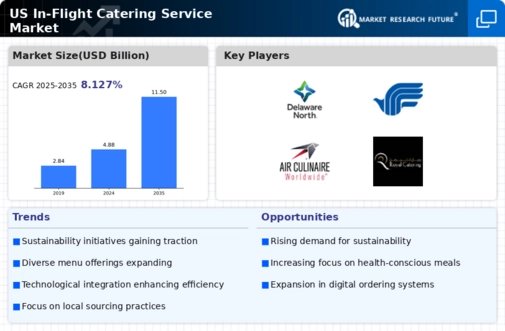Sustainability Initiatives
Sustainability has emerged as a pivotal driver in the in flight-catering-service market. Airlines are increasingly adopting eco-friendly practices, such as sourcing local and organic ingredients, reducing food waste, and utilizing biodegradable packaging. This shift is largely driven by consumer preferences, as travelers are becoming more environmentally conscious. A survey indicated that over 70% of passengers prefer airlines that demonstrate a commitment to sustainability. Consequently, airlines are investing in sustainable catering solutions, which not only appeal to eco-conscious consumers but also enhance brand loyalty. The integration of sustainability into catering services is expected to grow, potentially influencing up to 30% of purchasing decisions in the in flight-catering-service market.
Changing Consumer Preferences
The in flight-catering-service market is significantly influenced by changing consumer preferences. Passengers are increasingly seeking diverse and culturally relevant meal options that reflect their dietary needs and preferences. This trend is particularly evident among millennials and Gen Z travelers, who prioritize unique culinary experiences. Airlines are responding by diversifying their menus to include vegetarian, vegan, and gluten-free options, catering to a broader audience. Data suggests that airlines offering diverse meal choices can enhance customer satisfaction by up to 20%. This shift in consumer behavior is reshaping the in flight-catering-service market, compelling airlines to adapt their offerings to meet evolving expectations.
Rising Demand for Premium Services
The in flight-catering-service market experiences a notable increase in demand for premium offerings. As airlines strive to enhance passenger experience, they are investing in high-quality meals and gourmet options. This trend is particularly pronounced among business and first-class travelers, who are willing to pay a premium for superior dining experiences. According to recent data, the premium segment of the in flight-catering-service market is projected to grow by approximately 15% annually. Airlines are increasingly collaborating with renowned chefs and culinary brands to elevate their meal offerings, thereby attracting more affluent customers. This shift towards premium services not only enhances customer satisfaction but also contributes to the overall profitability of airlines, making it a crucial driver in the in flight-catering-service market.
Technological Advancements in Catering
Technological advancements play a significant role in shaping the in flight-catering-service market. Innovations such as online pre-ordering systems and mobile applications allow passengers to customize their meal choices before boarding. This not only enhances the customer experience but also streamlines operations for airlines. Furthermore, the use of data analytics enables airlines to better understand passenger preferences, leading to more tailored meal offerings. The integration of technology is projected to increase efficiency in catering operations by up to 25%, thereby reducing costs and improving service delivery. As technology continues to evolve, its impact on the in flight-catering-service market is likely to expand, offering new opportunities for growth and innovation.
Regulatory Compliance and Safety Standards
Regulatory compliance and safety standards are critical drivers in the in flight-catering-service market. Airlines must adhere to stringent food safety regulations set by authorities such as the FAA and USDA. These regulations ensure that all food served on flights meets health and safety standards, which is paramount for passenger safety. Compliance with these regulations not only protects consumers but also enhances the reputation of airlines. Failure to meet safety standards can result in significant financial penalties and damage to brand image. As such, airlines are increasingly investing in quality control measures and training for catering staff, which is likely to influence operational costs and service quality in the in flight-catering-service market.















Leave a Comment